|
Andrew Johnson National Cemetery: Andrew Johnson National Historic Site
The Andrew Johnson National Historic Site honors the life of the 17th President. Andrew Johnson's
presidency, 1865-1869, illustrates the United States Constitution at work following President Abraham Lincoln's assassination and during attempts to reunify a nation torn by civil war. His presidency shaped the future of the United States
and his influences continue today.
Andrew Johnson's final resting place is on a
high hill known as Monument Hill. President Johnson was buried with the American flag wrapped around him and with his head
resting on the Constitution of the United States.
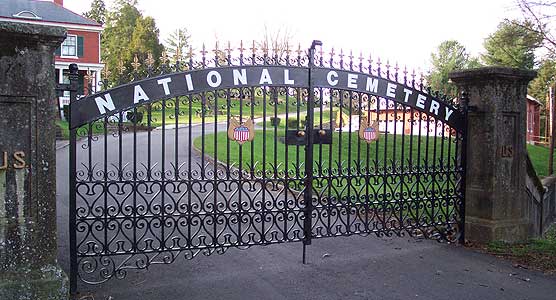
| National Park Service |
| Andrew Johnson National
Cemetery: Andrew Johnson National Historic Site |
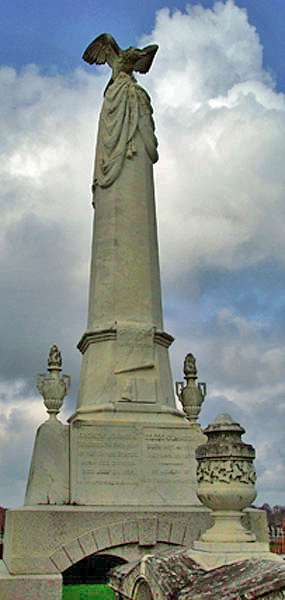
Welcome to Monument Hill.
(Right) Grave marker of President and Mrs. Andrew Johnson. National Park Service.
The land that comprises the Andrew Johnson National Cemetery was bought by
Andrew Johnson in 1852. According to family tradition, Johnson enjoyed coming to this spot for peace and meditation. It afforded
superb and unpopulated views of the mountains in the distance. Because of its height, it was used during the Civil War for
signaling, and it became known as “Signal Hill.”
It was Andrew Johnson’s request that he be buried here, and he was,
on the 3rd of August, 1875. At the crest of the hill, the Masons carried out the rites of burial.
The family erected the tall obelisk over Andrew and Eliza Johnson’s
grave in 1878. There was a dedication ceremony, and afterwards, this became known as “Monument Hill.”
Also during the dedication ceremony, recognition was given to two of Johnson’s
sons, Charles and Robert. They had preceded their father in death, and had been buried elsewhere. Charles, a surgeon during
the Civil War, had fallen from a horse and died in 1863 at the age of 33. Robert, his father’s private secretary, had
died shortly after the family’s return from Washington in 1869 at the age of 35. Charles had been buried in the Mt.
Olivet Cemetery in Nashville, Robert probably in the Old Harmony Cemetery here in Greeneville. They were reinterred before this occasion, and two neat, matching stones mark their resting place today.
"...there is no such thing as reconstruction. These States have not gone
out of the Union, therefore reconstruction is unnecessary. I do not mean to treat them as inchoate States, but merely as existing
under a temporary suspension of their government, provided always they elect loyal men. The doctrine of coercion to preserve
a State in the Union has been vindicated by the people. It is the province of the Executive to see that the will of the people
is carried out in the rehabilitation of the rebellious States, once more under the authority as well as the protection of
the Union." President Andrew Johnson on Reconstruction
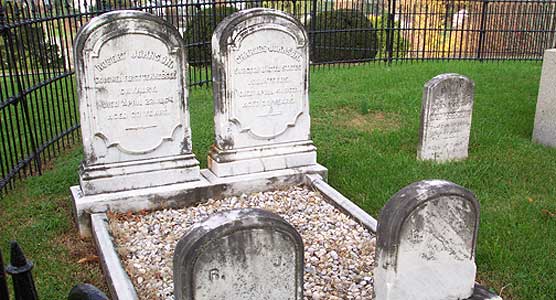
| National Park Service |
| Gravesites of Charles and Robert
Johnson |
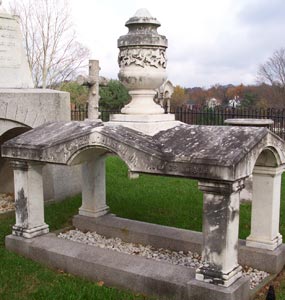
Andrew Johnson Jr. was the youngest of the Johnson sons. He was commonly
referred to as "Frank."
Andrew Jr. was the only Johnson son to marry. He married Bessie Rumbough
of Hot Springs, NC and found occupation first as a newspaper editor and later as manager of a cotton mill. He only
outlived his parents by four years.
(Left) Gravesite of Andrew Johnson, Jr. National Park Service.
Even though Andrew Jr. was the only Johnson son to marry, he and his wife
had no children. His marker reads “To the memory of my husband.”
Andrew Johnson granted four Amnesty Proclamations to the South following
the Civil War. Anyone excluded in the first amnesty plans could appeal directly to the President for a pardon. On Christmas
day, 1868, Andrew Johnson granted full amnesty to the former Confederates, including Confederate President Jefferson Davis.
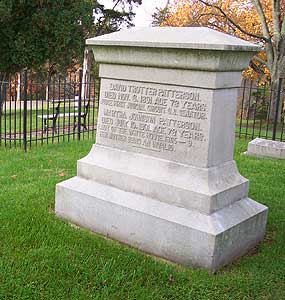
The two Johnson daughters, Martha and Mary, are buried in the family plot
as well.
Andrew Johnson was impeached, but not removed from office. He was the
first president to be impeached by the House of Representatives and tried by the Senate. Many Republican Senators put their
political careers on the line by voting to acquit.
(Right) Patterson Gravesite. National Park Service.
Martha had served as White House hostess for her mother, Eliza Johnson, and
Martha’s husband, David Trotter Patterson, had been one of Tennessee’s Senator at the time of Johnson’s
impeachment. Patterson cast one of the “not guilty” votes during the trial.
Martha lost both David and their daughter Belle within months of each other
in 1891. Martha, however, lived longer than any of the other Johnson children. She witnessed the turn of a century, and died
in 1901.
Alaska was purchased from Russia for $7,200,000.00 during Andrew Johnson's
administration. Secretary of State William Seward was instrumental in the purchase. People who thought the investment a bad
idea called the purchase "Seward's Folly."
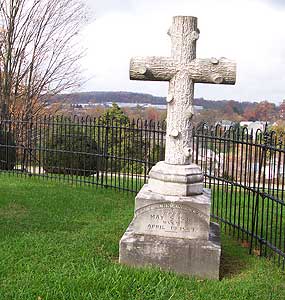
Mary Johnson Stover was laid to rest here in 1883. She and her first husband,
Daniel Stover, had three children, Sarah, Lillie, and Andrew Johnson Stover. They lived in Carter County, TN. Daniel died
during the Civil War, and the widowed Mary moved to the White House with her parents. She preceded the family's return to
Greeneville to renovate and restore the family home.
Mary married William Brown a short time later; they divorced after the deaths
of her parents. Both of her husbands are buried elsewhere, but her children and descendants are in the Johnson family plot.
(Left) Gravesite of Mary Johnson Stover Brown. National Park Service.
Mary's two daughters followed her in death only 3 and 9 years later.
Queen Emma of the Sandwich Islands (now known as the Hawaiian Islands)
came to visit President Andrew Johnson in Washington. It was the first time a Queen had visited the White House. She gave
this ivory basket to President and Mrs. Johnson. It is now on display in the Andrew Johnson NHS museum.
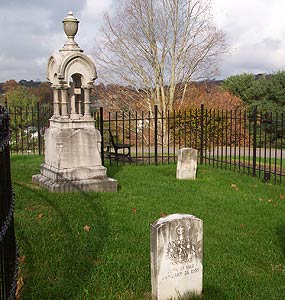
If you look at the headstone of Mary's daughters, Lillie and Sarah, you will
notice that it is somewhat different in style than the others ~ both of these girls converted to Catholicism, and there
is Catholic influence on their marker.
(Right) Granddaughter's Monument. National Park Service.
Their brother, Andrew Johnson Patterson, is buried beside them.
Two markers in front of these headstones (one shown) belong to Andrew Johnson
Bachman and Ethel I. Bachman, a great-grandson and great-granddaughter-in-law.
According to William Johnson, a former slave belonging to Andrew Johnson,
William's mother Dolly asked Andrew Johnson to purchase her because she thought he looked kind. Johnson bought not only Dolly,
but her brother Sam as well.
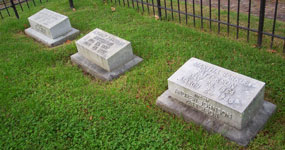
(Left) Patterson and Bartlett Gravesites. National Park Service.
These three headstones belong to Andrew Johnson Patterson, his wife Martha
Barkley Patterson, and their daughter Margaret Johnson Patterson Bartlett. Andrew Johnson Patterson was the grandson of Andrew
Johnson through Martha. These three were pivotal in the preservation of all that would become the Andrew Johnson National
Historic Site. Margaret Johnson Patterson Bartlett had tea with Franklin and Eleanor Roosevelt at the White House. There she
championed her cause. Later, after the fulfillment of her dream, she delighted many visitors as she led them on a very personal
tour of the president’s home. She worked with the park until 1976 ~ she had lived at the Homestead until 1956. When
she died in 1992, she laid in state in the Homestead parlor, and she became the last family member to be buried in this family
plot.
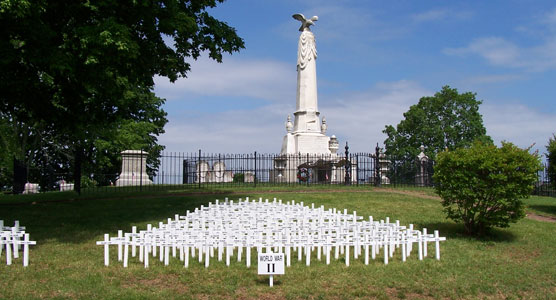
| National Park Service |
| National Cemetery with WW2 crosses |
The cemetery was owned by the family until 1906. From 1906 until 1942, the
cemetery was under the jurisdiction of the War Department. The first veteran burial took place in 1908 ~ one hundred
years after the birth of Andrew Johnson. By 1939, there were 100 graves.
When the NPS took over in 1942, their original policy was to allow no more
burials. The DAR and American Legion, however, began lobbying for the reactivation of the Cemetery, and in 1946 they found
success. The cemetery is still active today. This is one of the few cemeteries administered by the National Park Service to
have soldiers other than those who fought in the Civil War. Here you will find veterans from the Civil War, the Spanish-American
War, WW1, WW2, the Korean War, and Vietnam.
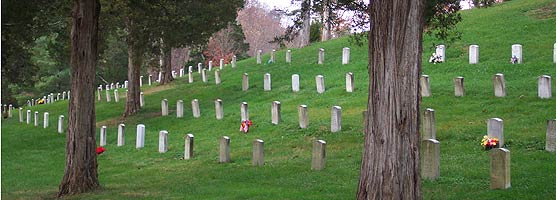
National Park Service
The National Cemetery today
Sources: Andrew Johnson National Cemetery; Andrew Johnson
National Historic Site; National Park Service.
Recommended
Reading: Andrew Johnson : A Biography (Signature Series) (Hardcover). Description: On April 14, 1865, just as the American
Civil War came to an end, Abraham Lincoln was assassinated by a Confederate actor. The next morning Andrew Johnson was suddenly
elevated to the position of president of the United States at a time when the nation was still
suffering from the effects of war. This biography explores the enigma of the homeless and uneducated tailor whose spectacular
rise to power ended in disgrace. It relates how his term in office undermined the process of reconstruction and left a legacy
of racism. Over a century later, Johnson remains the only president of the United States to have been
impeached. The author explores Johnson's undeniable skills as a political leader and his stubborn attachment to a mythical
view of the America
of his youth, which proved to be his undoing. Continued below…
From Library
Journal: Known for his Carl Schurz: A Biography (LJ 2/15/82), Trefousse delivers the first Johnson study in years, a definitive
assessment of his career and presidency. Johnson's papers and other sources reveal his fatal idealization of the agrarian
utopia, his fierce advocacy of strict Constitutional constructionism, and his imprudent insistence upon the Republican Party’s
adoption of his views on race. Trefousse demonstrates that Johnson, because of his upbringing, was out of step with the great
changes emerging at the end of the Civil War. His stubborn attachment to his increasingly archaic views was responsible for
his political and military success, but also for his impeachment. A brilliant, compassionate portrait of a dynamic era of
social change and national healing, and of the tragic failure of an American leader. Not to be missed. --Susan E. Parker,
Harvard Law Sch. Library. About the Author: Hans L. Trefousse is professor of history at Brooklyn
College and the Graduate Center of the City University of New York. His other books
include The Radical Republicans, a path breaking history of Reconstruction.
Recommended
Reading: Impeached: The Trial of President Andrew Johnson and the Fight for
Lincoln's
Legacy. Description: From School Library Journal: One of our more controversial political figures,
Andrew Johnson came closer than any other U.S. President to being removed from office through impeachment. This study by Stewart
(Summer of 1787: The Men Who Invented the Constitution), a Washington lawyer who has argued against impeachment in Senate proceedings,
examines Johnson's rocky relationship with the post-Civil War radical Republicans. Continued below…
He breaks with
those historians who have suggested that Johnson followed what would have been Lincoln's
path to reconstruct the South, as he discusses the complex impeachment proceedings against Johnson and the effectiveness of
the impeachment process in calming political tensions, if not in removing Presidents from office. Readers who wish to broaden
their understanding of Lincoln in this anniversary year will do well to select this well-researched work even if their collection
already includes such examinations as Howard Mean's narrower The Avenger Takes His Place: Andrew Johnson and the 45 Days That
Changed the Nation.—Theresa McDevitt, Indiana Univ. of Pennsylvania Library. From Publishers Weekly: Fresh from his
masterful The Summer of 1787, Stewart takes on one of the seamiest events in American history: the vengeful impeachment of
Lincoln's
successor as president; the Senate failed to convict Andrew Johnson by a single vote. At issue was the continuation of Lincoln's
plans to reintegrate the South into the union after the Civil War. But also at stake, as always, was party politics. Stewart
takes readers through a tangled web of motives and maneuverings in lively, unadorned prose. He's skilled at characterizing
his large cast of characters and, as a lawyer, has a practiced nose for skullduggery, of which there was much. Corruption
deeply marred the entire impeachment effort. Justifiably, Stewart holds his nose about most of the people involved and admires
few of them. As he sums it up, in 1868 none of the country's leaders was great, a few were good, all were angry, and far too
many were despicable. Stewart offers little analysis and advances no new ideas about what he relates, but he tells the story
as well as it's ever been told. Black and white photos.
Recommended
Reading: Andrew Johnson: The American Presidents Series: The 17th President, 1865-1869 (Hardcover). Description: The unwanted president who ran afoul
of Congress over Reconstruction and was nearly removed from office. Andrew Johnson never expected to be president, but just
six weeks after becoming Abraham Lincoln’s vice president, the events at Ford’s Theatre thrust him into the nation’s
highest office. Continued below…
Johnson faced
a nearly impossible task—to succeed America’s
greatest chief executive, to bind the nation’s wounds after the Civil War, and to work with a Congress controlled by
the so-called Radical Republicans. Annette Gordon-Reed, one of America’s leading historians
of slavery, shows how ill-suited Johnson was for this daunting task. His vision of reconciliation abandoned the millions of
former slaves (for whom he felt undisguised contempt) and antagonized congressional leaders, who tried to limit his powers
and eventually impeached him. The climax of Johnson’s presidency was his trial in the Senate and his acquittal by a
single vote, which Gordon-Reed recounts with drama and palpable tension. Despite his victory, Johnson’s term in office
was a crucial missed opportunity; he failed the country at a pivotal moment, leaving America
with problems that we are still trying to solve. About the Author: Annette Gordon-Reed is a professor of law at New York Law School,
where she has taught since 1992. She is the author of the celebrated Thomas Jefferson and Sally Hemings: An American Controversy,
co-author with Vernon Jordan
of Vernon Can Read!, and editor of Race on Trial: Law and Justice in American History. She lives in New York City.
Recommended
Reading: The Presidency of Andrew Johnson (American Presidency Series) (Hardcover). Description: Andrew Johnson, who became president
after the assassination of Lincoln,
oversaw the most crucial and dramatic phase of Reconstruction. Historians have therefore tended to concentrate, to the exclusion
of practically everything else, upon Johnson's key role in that titanic event. Although his volume focuses closely on Johnson's
handling of Reconstruction, it also examines other important aspects of his administration, notably his foreign, economic,
and Indian policies. As one of the few historians to do this, the author provides a broader and more balanced picture of Johnson's
presidency than has been previously available. Continued below…
Johnson has
always been an enigma: much is known about what he did, little about why he did it. He wrote few letters, kept no diary, and
rarely confided in anyone. Most historians either admire or despise him, depending on whether they consider his Reconstruction
policies right or wrong. Castel achieves an objective reassessment of Johnson and his presidential actions by examining him
primarily in terms of his effectiveness in using power and by not judging him--as most other scholars have--on moralistic
or ideological grounds. The book begins with an overview of America at the end of the Civil War and a description
of Johnson's political career prior to 1865. Castel recounts the drama of Johnson's sudden inheritance of the presidency upon
Lincoln's
death and then examines how Johnson organized and operated his administration. Johnson's formulation of a Reconstruction policy
for the defeated South comes under special scrutiny; Castel evaluates Johnson's motives for that policy, its implementation,
and its reception in both North and South. He descries and analyzes Johnson's quarrel with the Republican dominated Congress
over Reconstruction, the triumph of the Republicans in the election of 1866, the president's frustrated attempt to remove
Secretary of War Edwin M. Stanton from office, his bitter dispute with General Ulysses S. Grant, and his impeachment by Congress.
Johnson's impeachment trial is covered in detail; Castel explains how it was that Johnson escaped conviction and removal from
office by the narrowest possible margin. The book concludes with a discussion of Johnson's place in history as judged by scholars
during the past one hundred years. This study sheds light on the nation's problems during the chaotic period between 1865
and 1869 and contributes a great deal to a much improved understanding of the seventeenth president. This book is part of
the American Presidency Series.
Recommended
Reading: Race and Reunion: The Civil War in American Memory. Description: From Publishers Weekly: Almost all the dominant views
of the Civil War and its aftermath, including Reconstruction and "reunion," prevalent in this country until the coming of
the civil rights movement, were the direct result of an extensive Southern propaganda war, argues Blight (Amherst College
professor of history and black studies), remnants of which are still flourishing in various racist subcultures. As W.E.B.
Du Bois noted a century ago, shortly after the war, the North was tacitly willing to accept the South's representation of
the conflict in exchange for an opening of new economic frontiers. Continued below…
Blight sets
out to prove this thesis, surveying a mass of information (the end notes run to almost 100 pages) clearly and synthetically,
detailing the mechanics of mythmaking: how the rebels were recast as not actually rebelling, how the South had been unjustly
invaded, and how, most fabulously of all, the South had fought to end slavery which had been imposed upon it by the North.
His argument that this "memory war" was conducted on a conscious level is supported by the Reconstruction-era evidence of
protest, by blacks and whites alike, that he unearths. Yet these voices failed to dissuade the vast majority of Americans
both North and South who internalized some version of the story. This book effectively traces both the growth and development
of what became, by the turn of the 20th century and the debut of The Birth of a Nation, the dominant racist representation
of the Civil War. A major work of American history, this volume's documentation of the active and exceedingly articulate voices
of protest against this inaccurate and unjust imagining of history is just one of its accomplishments. (Feb. 19) Forecast:
This book will be the standard for how public perceptions of the Civil War were formed and propagated in a manner directly
analogous to today's doublespeak and spin control. It will be a regular on course syllabi, and will be glowingly reviewed,
but the wealth and diversity of sources may keep some general readers away. From Booklist: The year 1913 saw two separate
ceremonies commemorating great events 50 years previously: elderly Union and Confederate veterans shook hands at the Gettysburg
battlefield, and W.E.B DuBois staged an elaborate "National Emancipation Exposition." Together they struck discordant chords
of memory about the Civil War, which Blight examines in this incisive discussion of how the conflict was popularly remembered
in the half-century following Appomattox.
He closely examines the types of memorializations of the war, such as the creation and observance of Memorial Day, the erection
of statues to Robert E. Lee and Robert Gould Shaw, soldiers' reunions, soldiers' memoirs, popular literature, and anniversary
orations by such figures as Frederick Douglass. Within these modes of expression Blight recounts the strong tide in the post-war
years for "reunion on Southern terms," politically by the overthrow of the Republican Reconstruction governments in the South,
and ideologically in "Lost Cause" writings justifying secession and slavery. Freed blacks suffered the consequence of the
ascendance of a sentimental view of the war and amnesia about its central issue.
Recommended
Reading: Abraham Lincoln (The American Presidents Series: The 16th President, 1861-1865) (Hardcover). Description:
America’s greatest
president, who rose to power in the country’s greatest hour of need and whose vision saw the United States
through the Civil War. Abraham Lincoln towers above the others who have held the office of president—the icon of greatness,
the pillar of strength whose words bound up the nation’s wounds. His presidency is the hinge on which American history
pivots, the time when the young republic collapsed of its own contradictions and a new birth of freedom, sanctified by blood,
created the United States
we know today. His story has been told many times, but never by a man who himself sought the office of president and contemplated
the awesome responsibilities that come with it. Continued below…
George S. McGovern—a
Midwesterner, former U.S.
senator, presidential candidate, veteran, and historian by training—offers his unique insight into our sixteenth president.
He shows how Lincoln
sometimes went astray, particularly in his restrictions on civil liberties, but also how he adjusted his sights and transformed
the Civil War from a political dispute to a moral crusade. McGovern’s account reminds us why we hold Lincoln in such esteem and
why he remains the standard by which all of his successors are measured. George S. McGovern represented South Dakota in the United
States Senate from 1963 to 1981 and was the Democratic nominee for president in 1972. He was a decorated bomber pilot in World
War II, after which he earned his Ph.D. in American history and government at Northwestern University.
A recipient of the Presidential Medal of Freedom, he lives in Mitchell, South Dakota.
Abraham Lincoln, who came into the presidency in the country’s greatest hour of need, towers above the others who have
held the office of president—the icon of greatness, the pillar of strength whose words bound up the nation’s wounds.
His vision saw the United
States through the Civil War. His presidency is the hinge
on which American history pivots, the time when the young republic collapsed of its own contradictions and a new birth of
freedom, sanctified by blood, created the United States we know today. His story has been
told many times, but never by a man who himself sought the office of president and contemplated the awesome responsibilities
that come with it. George S. McGovern—a Midwesterner, former U.S. senator, presidential
candidate, veteran, and historian by training—offers his unique insight into our sixteenth president. He shows how Lincoln
sometimes went astray, particularly in his restrictions on civil liberties, but also how he adjusted his sights and transformed
the Civil War from a political dispute to a moral crusade. McGovern’s account reminds us why we hold Lincoln in such esteem and
why he remains the standard by which all of his successors are measured. "The greatness and imperfections of America's
16th president, captured by a former Democratic nominee for the White House. With considerable skill and insight, McGovern
crafts a biography snappy, clear and comprehensive enough to please general readers, students and scholars alike. In eight
short chapters, six of which deal with Lincoln's presidency,
he nails the essential strengths, flaws, failures and achievements of America's most revered
leader."—Kirkus Reviews. "McGovern’s Lincoln
is a finely wrought gem. In this small volume McGovern captures Lincoln’s character and leadership strengths better than many
weighty tomes. It is a worthy addition to the brilliant American Presidents Series."—Doris Kearns Goodwin. "If you like
your biographies very short and sweet with a dash of corrective moralism, you might try George McGovern's Abraham Lincoln,
a well-timed entry in Times Books' presidents series, written by the former White House candidate."—David Waldstreicher,
The Boston
Globe. "Lincoln
is one of the few presidents to be claimed by both liberals and conservatives. This volume by the former Democratic presidential
candidate (in the American President Series from Times Books, edited by Arthur M. Schlesinger Jr. and Sean Willentz) examines
Lincoln's record from a liberal point of view, particularly his early and apparent contradictory views on slavery—his
platform made clear that his purpose was to contain slavery in the Southern states, not to abolish it. An example: In our
16th president, writes McGovern, 'We see the decency of popular government. Its role, then as now, was, as Lincoln wrote "to elevate the
condition of men . . . to afford all an unfettered start in the race of life" . . . To him, democracy was an experiment that
the world had not seen before.' Simply put, McGovern makes a convincing case that America's
first Republican president was really our first democratic president."—Allen Barra, The Star-Ledger (Newark). "The greatness and
imperfections of America's
16th president, captured by a former Democratic nominee for the White House. With considerable skill and insight, McGovern
crafts a biography snappy, clear and comprehensive enough to please general readers, students and scholars alike. In eight
short chapters, six of which deal with Lincoln's presidency,
he nails the essential strengths, flaws, failures and achievements of America's most revered leader.
Born in a Kentucky log cabin, Lincoln was a melancholic who
suffered more than his fair share of misfortune. According to McGovern, he nevertheless earned success through his ceaseless
hard work, powerful intellect and incomparable abilities as a speechwriter. Lincoln began his political career as a member
of the Whig Party. After serving in the Illinois state legislature, he won election to the U.S. Congress in 1846, but lost
support by challenging President James Polk on the origins of the Mexican War and lasted only one term. The 1854 Kansas-Nebraska
Act, sponsored by Democratic Senator Stephen Douglas, reinvigorated Lincoln's political ambitions. While he believed the Constitution did
not allow for abolition in the South, he staunchly opposed the westward expansion of slavery. With the Whig Party split, he
joined the new Republican Party in 1856 and ran against Douglas
for a Senate seat in 1858. Although he lost this race, Lincoln
gained national prominence as a result of his famous debates with Douglas.
Two years later, he won the 1860 presidential election, a victory that angered the South and brought about secession and war.
What was he like as a wartime president? In three core chapters, McGovern astutely assesses Lincoln's emergence as a commander
in chief committed to 'total war.' The author does not shy away from criticizing his subject, particularly for suspending
habeas corpus and censoring the press. Still McGovern's overall depiction is one of a complex, tolerant and extraordinary
man who simultaneously preserved the Union and transformed
the nation. Compact and commanding."—Kirkus Reviews. "Former U.S. senator McGovern—who
is also a Ph.D. historian—knows something about presidential leadership and the potential and actual abuses of power
that come especially during wartime. In this compact but convincing portrait, he assesses Lincoln's greatness in terms of
his ability to use his humble origins, empathy, keen sense of justice, uncommon skill in seeing the essence of an issue, faith
in American democracy, gifts of language, and personal self-confidence—all to become a masterly lawyer, a party leader,
commander in chief, and a heroic figure with both the vision and the practicality to realize his purposes . . . Given his
own politics. About the Author: George S. McGovern represented South Dakota in the United States Senate from 1963 to 1981 and was
the Democratic nominee for president in 1972. He was a decorated bomber pilot in World War II, after which he earned his Ph.D.
in American history and government at Northwestern
University. A recipient
of the Presidential Medal of Freedom, he lives in Mitchell,
South Dakota.
|

